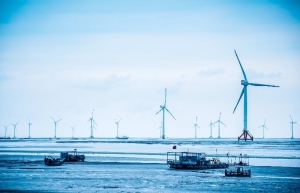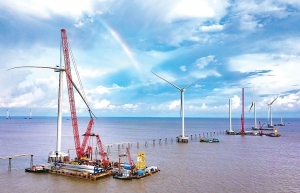Clarity still to be obtained for offshore wind policy
What is expected to occur in the short term, in terms of boosting regulations on marine surveys?
 |
| Dr. Du Van Toan, director of the Marine Resource Management and Research for the Vietnam Administration of Seas and Islands, under the Ministry of Natural Resources and Environment |
The ministry has finalised the draft decree amending and adding to several articles of Decree No.40/2016/ND-CP, which details a number of articles of the Law on Natural Resources and Environment of Sea and Islands as well as Decree No.11/2021/ND-CP.
New documents enhance regulations on evaluation procedures and issue a three-year written approval for the measurement, monitoring, and evaluation of marine resources. If the government permits, these documents could be released in the third quarter, facilitating the licensing of marine surveys and the construction of the first 3GW of offshore wind power experimental projects in the country.
Vietnam has an offshore wind power potential of up to 600GW, but marine survey licensing is plagued by numerous issues relating to criteria, capacity, experience, and construction capability. Therefore, only two wind measurement projects have been licensed to date. Permits for offshore wind energy surveying have been requested by 41 developers.
What is your key warning when it comes to carrying out surveys?
Due to the multiple phases of the survey, investors should not conduct multiple surveys simultaneously. The first survey is a wind measurement survey, while the geological and engineering survey should not be conducted until the state management agency confirms the project’s economic viability. The cost of a wind measurement survey is not excessively high, whereas geological surveys and engineering projects incur astronomical costs. Currently, the greatest obstacle for investors is the lack of clarity surrounding the policy and mechanism governing electricity price formation. Foreign investors have not yet been attracted by investment incentives, and power generation on the grid is dependent on the transmission capacity of the national power grid.
Can you tell us why wind measurement surveying is a priority?
Vietnam has offshore wind power potential, but not all seas are suitable for deployment. From Binh Dinh to Ninh Thuan provinces, and from Binh Thuan to Ca Mau provinces, and a portion of the central waters of the Gulf of Tonkin are the sea areas with the greatest wind energy potential, according to a study published last year.
The greatest wind energy in Vietnam is found in the coastal regions of Ninh Thuan and Binh Thuan. At the 100m level in this region, wind velocity exceeds 10 metres per second, and the wind energy density reaches 1,200-1,400MW per square metre.
Khanh Hoa (including Spratly Islands) is the province with the longest coastline at 370km, the largest sea surface area at 37,000 square kilometres, and the maximum wind energy resource at 259,000MW. Next is Ca Mau, which has 254km of coastline, 25,400sq.km of sea, and 203,200MW of estimated wind energy resources.
In addition, areas such as the islands of Phu Quy, Bach Long Vi, and Spratly Islands have abundant wind energy resources that can be used to develop large offshore wind power projects.
Will legal obstacles prevent the development of this energy source?
The legal structure for renewable energy and offshore wind is undergoing development. To accomplish the objectives of the Power Development Plan VIII, the legal framework for offshore wind power must be finalised as soon as possible, including the early adoption of a long-term marine spatial plan coordinated with other economic sectors.
Vietnam may gain knowledge from the global experience in developing and publishing legal documents to finalise the offshore wind power law. Australia and the United States both have offshore wind power regulations that limit the minimum and maximum area of a project. A survey permit is restricted to 700sq.km by Australian laws, for example.
 | Vietnam’s offshore wind realm remains in a muddle The strategy for renewable energy development being in limbo is holding back offshore wind power prospects in Vietnam. |
 | Vietnam needs to modify policies to foster offshore wind power According to Vietnam's new electricity strategy, the objective is to ensure the overall capacity of offshore wind power reaches 6 GW by 2030 and 7-9GW by 2050. This will assure energy safety as well as meet the rising needs of the whole nation, in pace with its socioeconomic development. |
 | Marine planning a prerequisite for offshore investment plans Vietnam may require a more active planning process and appropriate policies to reach its offshore wind capacity goal of 6GW by 2030. |
What the stars mean:
★ Poor ★ ★ Promising ★★★ Good ★★★★ Very good ★★★★★ Exceptional
Related Contents
Latest News
More News
- Schaeffler reports strong early output from Dong Nai solar project (December 12, 2025 | 15:16)
- Forestry conference highlights biodiversity and sustainability goals (December 09, 2025 | 13:35)
- Home Credit honoured among top 10 sustainable companies in trade and services (December 09, 2025 | 12:18)
- SCG and seven member companies honoured in Top 100 Sustainable Businesses 2025 (December 08, 2025 | 09:00)
- Nestlé Vietnam pioneers sustainable development and promotes business connections (December 06, 2025 | 12:09)
- CSI 2025 highlights rise of Vietnam’s green champions (December 06, 2025 | 09:00)
- Acecook Vietnam named among top 100 sustainable businesses (December 06, 2025 | 08:00)
- Vietnam’s forest carbon credits draw global interest (December 05, 2025 | 17:41)
- Coro Energy to launch BESS Pilot in Vietnam (December 04, 2025 | 15:12)
- Vietnam strengthens energy storage pathway (December 04, 2025 | 15:05)

 Tag:
Tag:






















 Mobile Version
Mobile Version